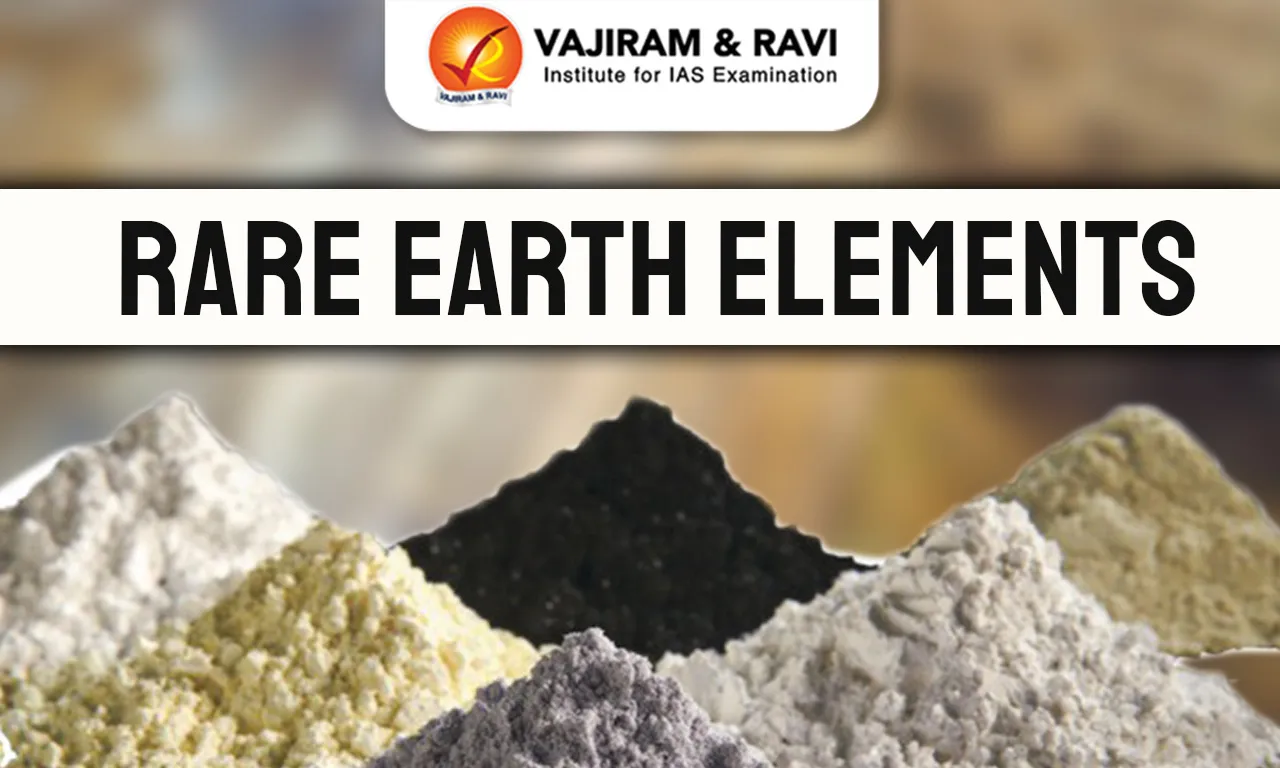The Rare Earth Elements (REEs) are 17 metals in Group 3 of the Periodic Table comprising Lanthanide series elements and Scandium and Yttrium (due to similar physical properties and found in the same ores and deposits). Contrary to their name, they are moderately abundant in nature but not concentrated enough to make them economically exploitable. India has the fifth-largest rare earth resource globally, with mainly concentrated in its monazite minerals.
Rare Earth Elements are important components in over 200 products, spanning applications in consumer electronics, electric vehicles, defence systems, and many more. Demand for REEs is expected to rise with a focus on renewable energy, Electric Vehicles, and niche sectors like communications and nuclear energy.
What are Rare Earth Elements?
Scandium, Yttrium and the 15 Lanthanides, lanthanum (La), cerium (Ce), praseodymium (Pr), neodymium (Nd), promethium (Pm), samarium (Sm), europium (Eu), gadolinium (Gd), terbium (Tb), dysprosium (Dy), holmium (Ho), erbium (Er), thulium (Tm), ytterbium (Yb) and lutetium (Lu) are considered as the Rare Earth Elements.

- Types: Based on the atomic weight, Rare Earth Elements are divided into two groups - light REEs, those with atomic numbers from 57 to 63 (La, Ce, Pr, Nd, Pm, Sm and Eu) and heavy REEs, those with atomic numbers from 64 to 71 (Gd, Tb, Dy, Ho, Er, Tm, Yb and Lu).
- Scandium and Yttrium, although light, have been placed with the heavy REEs group due to their similar chemical and physical properties.
- Characteristics: REEs are characterised by high density, high melting point, high conductivity and high thermal conductance.
- Rare Earth Elements share a trivalent charge (+3) and similar ionic radii, hence similar properties.
- Sources: The principal sources of REE are bastnaesite (a fluorocarbonate which occurs in carbonatites and related igneous rocks), xenotime (yttrium phosphate) commonly found in mineral sand deposits, loparite which occurs in alkaline igneous rocks and monazite (a phosphate).
- Several rare-earth minerals contain thorium and uranium in variable amounts, but they do not constitute essential components in the composition of the minerals.
- Cerium is the most abundant rare earth, approximately the same as that of Copper.
- Significance: Rare Earth Elements are very important for futuristic technology.
- They have wide applications in clean energy, high-end electronics, defence, etc with no equal substitutes.
Applications of Rare Earth Elements
The versatile nature of rare earth elements is evident in their applications. Some of them are as follows:
- Permanent magnet: Neodymium magnets (Nd-Fe-B magnets) are permanent magnets made of neodymium, iron and boron.
- They have the highest magnetic properties of all permanent magnets and can withstand temperatures as high as 230 degrees C.
- They are used in automobiles for anti-lock brakes, in computer hard disk drives, CD-ROMs, digital cameras, etc.
- These magnets are also used in a variety of conventional automotive subsystems, such as power steering, electric windows, power seats, and audio speakers.
- Electronics and Displays: Rare Earth Elements are used in high-technology devices such as smartphones, hard disks, digital cameras, fluorescent and light-emitting-diode lights, computer monitors and electronic displays.
- Some rare earth elements have phosphorescent properties, which makes them to be used in the manufacture of flat television screens and computer monitors.
- Lanthanum makes up as much as 50 per cent of digital camera lenses, including cell phone cameras.
- Eu, Y, and Tb are used in the manufacturing of phosphors (substances that emit luminescence) to be used in many types of ray tubes and flat panel displays for screens that range in size from smartphone displays to stadium scoreboards.
- Erbium is used to make fibre optic cables and laser repeaters.
- Green Technologies: They play a critical role in green technologies such as wind turbines and electric vehicles that are going to support net zero carbon emissions goals.
- Nickel-metal hydride batteries are built with lanthanum-based alloys as anodes which are used in electric vehicles.
- Cerium-based catalysts are used in automotive catalytic converters.
- Lanthanum acts as a hydrogen absorber in rechargeable batteries and is an important element in hybrid car batteries.
- Petroleum Refining: Lanthanum is used as a catalyst for petroleum refining processes.
- Glass Industry: The glass industry is the largest consumer of REE raw materials, using them for glass polishing and as additives that provide colour and special optical properties.
- Water purifiers: Cerium shows a strong affinity for elements like phosphorus, hence used in water purifiers.
- Healthcare: REEs are also used in advanced medical technologies like MRIs, laser scalpels, non-irritating antiseptic dressings,and even some cancer drugs.
- Defence and Space: They are used in satellite communications, guidance systems and aircraft structures.
- Steel Making:Cerium, lanthanum, neodymium, and praseodymium, commonly in the form of a mixed oxide known as mischmetal, are used in steel making to remove impurities and in the production of special alloys.
- Other applications: The rare earth elements like promethium, samarium, and europium serve specific functions in applications such as beta radiation sources, high-temperaturemagnets, and fluorescent lighting, respectively.
Rare Earth Elements Concerns and Challenges
The Rare Earth Elements are very critical for the high-end modern technology but there are some environmental concerns and geopolitical challenges as well.
- Rare Earth Dilemma: Despite its applications in green and emerging technologies, the extraction of REEs causes environmental damage.
- The extraction of REEs often results in large amounts of toxic waste, contaminating air, water, and soil.
- For every ton of rare earth, 2,000 tons of toxic waste are produced.
- Every year, China produces tens of millions of tons of wastewater.
- This paradox is called the Rare earth Dilemma.
- Health risks: Rare earth ores are often laced with radioactive thorium and uranium, which can cause detrimental health effects while extracting.
- Monopoly of China: China has the largest reserves of REE, about 37% of the total global resources, followed by Brazil and Vietnam (18% each) and Russia (10%).
- China is also the largest producer, followed by the United States.
- Since the 1990s, China has provided 90-95 per cent of the world’s REEs.
- This gives China a monopoly over the supply chain of REEs.
- However, in recent years, countries like Australia, Brazil, Russia and the United States have made strides in increasing their production capabilities to reduce dependence on China.

Rare Earth Elements in India
India is the fifth-largest rare earth resource globally, with significant deposits in the monazite minerals.
- Resources: There are around 13.07 million tonnes of REEs, mainly found in the monazite sand, which contains 55-60% total Rare Earth Elements oxide. These are found in:
- Coastal beach placer monazite sands of Andhra Pradesh, Odisha, Kerala, Tamil Nadu, Maharashtra and Gujarat.
- Inland placer deposits of Jharkhand, West Bengal and Tamil Nadu.
- Types: India contains mainly Light REEs while Heavy REEs are not available in extractable quantities.
- Only Neodymium and Praseodymium are available in India and are being extracted up to the 99.9 % purity level.
- Mining: Indian Rare Earth Limited (IREL) is a major player in mining and processing, producing rare earth compounds.
- Foreign collaboration: Toyotsu Rare Earths India Limited, Visakhapatnam (Toyota Tsusho Corporation, Japan with IREL).
- Challenges: Despite abundant resources, India faces challenges in achieving self-sufficiency in rare earths.
- Economic Extraction: The primary challenge lies in their extraction and processing. This is due to their dispersed nature.
- Industrial Scale Facility: The existing ecosystem from mining to separation and refining in oxide form exists, but industrial-scale facilities for alloy and magnet production are lacking.
- Initiatives:
- Initiatives like the setting up of a Rare Earth Theme Park and joint ventures aim to enhance India's position in this critical industry.
- RE and Titanium Theme Park was developed by IREL to cater for the technologies developed by BARC.
- India is actively exploring collaborations, and initiatives such as Toyotsu Rare Earths India Limited in Visakhapatnam to enhance efforts to refine rare earths through foreign collaboration.
- Recently, a Carbonatite Deposit was found in Gujarat.
- IREL processing plants have been established in Ganjam, Odisha and Aluva, Kerala.
Rare Earth Elements UPSC PYQs
Question 1: Consider the following statements: (UPSC Prelims 2025)
Statement I:
Some rare earth elements are used in the manufacture of flat television screens and computer monitors.
Statement II:
Some rare earth elements have phosphorescent properties.
Which one of the following is correct in respect of the above statements?
a) Both Statement I and Statement II are correct and Statement II explains Statement I
b) Both Statement I and Statement II are correct but Statement II does not explain Statement I
c) Statement I is correct but Statement II is not correct
d) Statement I is not correct but Statement II is correct
Ans: (a)
Last updated on December, 2025
→ Check out the latest UPSC Syllabus 2026 here.
→ Join Vajiram & Ravi’s Interview Guidance Programme for expert help to crack your final UPSC stage.
→ UPSC Mains Result 2025 is now out.
→ UPSC Notification 2026 is scheduled to be released on January 14, 2026.
→ UPSC Calendar 2026 is released on 15th May, 2025.
→ UPSC Prelims 2026 will be conducted on 24th May, 2026 & UPSC Mains 2026 will be conducted on 21st August 2026.
→ The UPSC Selection Process is of 3 stages-Prelims, Mains and Interview.
→ UPSC Result 2024 is released with latest UPSC Marksheet 2024. Check Now!
→ UPSC Toppers List 2024 is released now. Shakti Dubey is UPSC AIR 1 2024 Topper.
→ Also check Best IAS Coaching in Delhi
Rare Earth Elements FAQs
Q1. What is known as rare earth elements?+
Q2. What are some of Earth's rarest elements?+
Q3. What is rare earth used for?+
Q4. Which rare earth element is rarest?+
Tags: quest rare earth elements

















